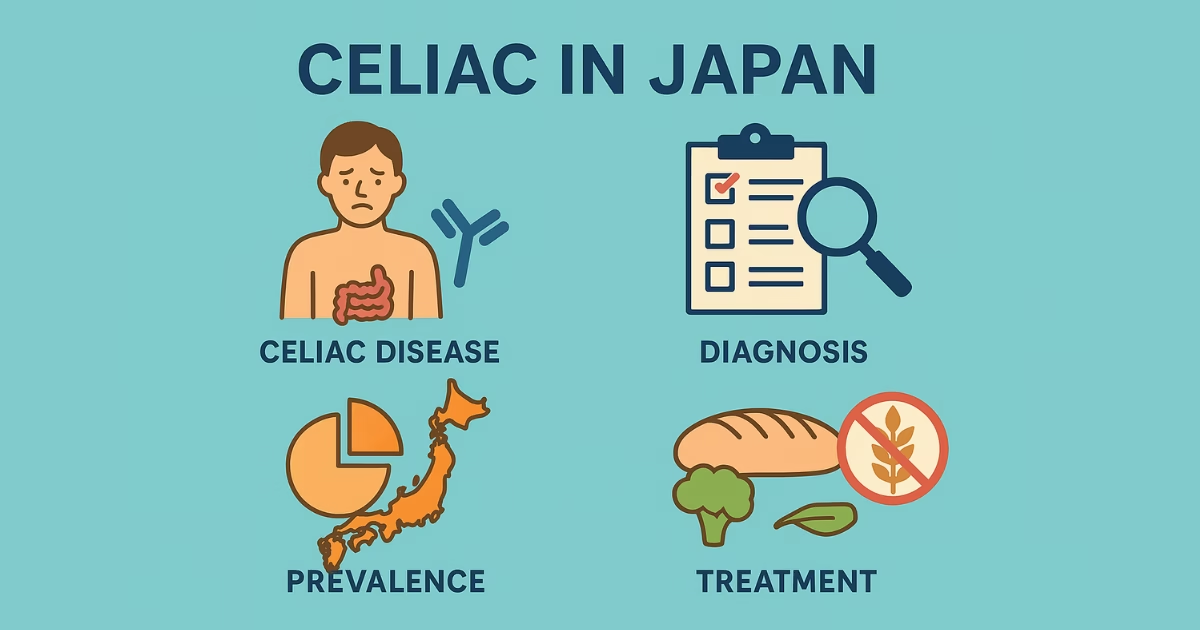Celiac disease is an autoimmune disorder that causes damage to the small intestine when gluten is consumed. While the condition is widely recognized in Western countries, it is relatively rare in Japan. However, with increasing awareness, more individuals are being diagnosed with this condition. The prevalence of celiac disease in Japan remains low compared to Western nations, largely due to genetic factors and dietary habits. Despite this, awareness is growing, and those living with celiac in Japan face unique challenges, especially when it comes to finding suitable foods and managing their diet. This article will explore the realities of celiac in Japan, including its prevalence, symptoms, diagnosis, treatment options, and the rising gluten-free market in the country.
What is Celiac Disease?
Celiac disease is a chronic autoimmune condition that affects the small intestine. When someone with celiac disease consumes gluten, a protein found in wheat, barley, and rye, their immune system mistakenly attacks the lining of the small intestine, causing inflammation and damage. This damage can lead to malabsorption of nutrients, leading to various health problems.
The symptoms of celiac disease can vary widely and may include digestive issues such as bloating, diarrhea, or constipation, as well as non-digestive symptoms like fatigue, joint pain, and skin rashes. If left untreated, celiac disease can lead to long-term complications, including osteoporosis, infertility, and an increased risk of certain cancers.
Globally, the prevalence of celiac disease has been rising as awareness increases. However, in Japan, it remains less common compared to Western countries, where rates are higher due to a combination of genetic factors and dietary patterns.
Celiac in Japan: Prevalence and Genetic Factors
Celiac disease is relatively rare in Japan compared to other countries, especially Western nations. The low prevalence can be attributed to a combination of genetic factors and dietary habits. Studies show that the genetic markers associated with celiac disease, specifically the HLA-DQ2 and HLA-DQ8 genes, are less common in the Japanese population than in those from regions with higher rates of celiac disease, such as Europe and North America.
The Japanese diet is traditionally low in gluten, with rice as the primary carbohydrate source instead of wheat. This may explain why celiac disease is less prevalent in Japan, as the typical exposure to gluten is minimal. Furthermore, traditional Japanese foods like sushi, rice, and fish don’t contain gluten, which could further lower the risk of developing the condition.
Despite its rarity, awareness of celiac disease is increasing in Japan as more people are being diagnosed, and as global travel and access to information spread knowledge about gluten intolerance and autoimmune diseases. Understanding the genetic factors and dietary habits that contribute to the lower prevalence of celiac disease in Japan is crucial for those living with the condition or at risk of developing it.
Diagnosis of Celiac Disease in Japan
Diagnosing celiac disease in Japan can be challenging due to the condition’s rarity and the lack of routine screenings for it. Many doctors in Japan may not immediately consider celiac disease as a potential cause of gastrointestinal symptoms, especially when the condition is not well-known in the country. As a result, individuals may face delays in receiving the proper diagnosis.
The diagnostic process for celiac disease typically involves blood tests to check for elevated levels of specific antibodies, such as anti-tissue transglutaminase (tTG) antibodies. If the blood tests are positive, a biopsy of the small intestine is usually performed to confirm the diagnosis. However, because celiac disease is uncommon in Japan, patients often undergo testing for other, more common gastrointestinal issues before being tested for celiac disease.
Additionally, the symptoms of celiac disease can overlap with other conditions, making diagnosis even more difficult. For example, symptoms like bloating, fatigue, and skin rashes can also be seen in conditions like irritable bowel syndrome (IBS) or food allergies, further complicating the diagnostic process. As awareness of celiac disease grows in Japan, it is hoped that more healthcare professionals will consider it as a potential diagnosis for patients exhibiting related symptoms.
Celiac Disease Symptoms and Diagnosis in Japan
While the symptoms of celiac disease can be similar worldwide, they may present differently in the Japanese population due to genetic and cultural factors. In many cases, individuals with celiac disease may experience digestive symptoms like bloating, diarrhea, and abdominal pain. However, it’s important to note that not everyone with celiac disease presents with these common symptoms.
In Japan, some people with celiac disease may have less obvious signs, such as fatigue, joint pain, or skin rashes like dermatitis herpetiformis, which is a common symptom of celiac disease. These non-digestive symptoms are often overlooked or misdiagnosed as other conditions, delaying the correct diagnosis.
Because gluten is not a major component of the traditional Japanese diet, many people may not immediately connect their symptoms to gluten consumption. This can lead to a lack of awareness about the possibility of celiac disease, and individuals may go undiagnosed for years. Therefore, it’s important for healthcare providers in Japan to consider celiac disease as a potential diagnosis, particularly when symptoms do not improve with more common treatments.
Treatment for Celiac Disease in Japan
The primary treatment for celiac disease is a strict, lifelong gluten-free diet. This means avoiding all foods and products that contain gluten, including wheat, barley, and rye. In Japan, this can pose a challenge, as gluten is present in many common foods, including soy sauce, a staple in Japanese cuisine. However, the growing availability of gluten-free products and alternative ingredients has made it easier for individuals with celiac disease to manage their condition.
In recent years, Japan has seen a rise in the availability of gluten-free products, including bread, noodles, and snacks. Health food stores, supermarkets, and even restaurants are beginning to offer gluten-free options, although they remain less common than in Western countries. However, for those living with celiac disease in Japan, the growing awareness of gluten-free diets has made it easier to find suitable foods.
For individuals with celiac disease, it’s essential to read labels carefully and seek out certified gluten-free products. In Japan, the certification process for gluten-free foods is still evolving, but many products are labeled with “gluten-free” for ease of identification. Restaurants catering to gluten-free diets are also beginning to appear, particularly in larger cities like Tokyo and Osaka.
Celiac Disease Market and Awareness in Japan
In recent years, there has been a noticeable shift in Japan toward greater awareness of celiac disease and gluten-free lifestyles. The increasing availability of gluten-free products in supermarkets and health food stores reflects this growing awareness. More people are becoming informed about celiac disease, thanks to global campaigns and increased access to information about gluten intolerance and autoimmune diseases.
The demand for gluten-free foods has led to an expansion of the market for gluten-free products in Japan, especially in urban centers where foreign expatriates and tourists are more likely to seek out these products. Additionally, there are more online resources and forums available for individuals living with celiac disease in Japan, which has further fueled awareness and education.
However, while gluten-free products are becoming more widely available, they are still considered niche items in Japan. As awareness continues to grow, it’s expected that the market for gluten-free products will expand even further, making it easier for individuals with celiac disease to maintain a safe and healthy diet.
Living with Celiac Disease in Japan
Living with celiac disease in Japan presents unique challenges, especially due to the prevalence of gluten in Japanese cuisine. Many traditional foods, such as soy sauce, tempura, and udon, contain gluten, making it difficult for individuals with celiac disease to dine out or enjoy local dishes. Additionally, cross-contamination is a concern, as many foods prepared in kitchens that handle gluten-containing ingredients may inadvertently come into contact with gluten-free items.
To navigate these challenges, individuals with celiac disease often need to be proactive about their diet and lifestyle. Some people find success by cooking at home, where they can ensure that their meals are completely gluten-free. For dining out, it’s helpful to find restaurants that offer gluten-free options or are willing to accommodate dietary restrictions.
In larger cities like Tokyo, there are more gluten-free restaurants, but these options may be limited in smaller towns or rural areas. People living with celiac disease in Japan often need to plan their meals ahead of time and communicate their dietary needs to restaurant staff to avoid accidental gluten consumption.
Future Outlook for Celiac Disease in Japan
As awareness of celiac disease continues to grow in Japan, the future looks promising for individuals with the condition. With the rise in the number of diagnosed cases and the expanding market for gluten-free products, there is hope that Japan will become more accommodating for those living with celiac disease.
Additionally, more research on the prevalence of celiac disease in Japan is needed to better understand how the condition affects the population. The future may bring improved diagnostic tools, better education for healthcare professionals, and a more widespread availability of gluten-free products, making it easier for individuals with celiac disease to live a healthier life in Japan.
Conclusion
Celiac disease may be relatively rare in Japan, but with growing awareness, the future looks brighter for those living with the condition. Understanding the genetic factors, dietary habits, and challenges surrounding diagnosis and treatment is essential for improving the lives of individuals with celiac in Japan. As the gluten-free market expands and more people are diagnosed, the landscape for living with celiac disease in Japan is gradually becoming more supportive. It is essential that both healthcare professionals and the general public continue to learn about celiac disease to ensure that those affected can live healthy, fulfilling lives.

Hi, I’m Shafy Ali – a curious mind and passionate writer at Celiac Magazine. I cover a little bit of everything, from everyday tips and how-tos to deeper dives into topics that spark conversation. I enjoy turning research into readable, relatable content that informs and inspires. Whatever the subject, I aim to keep it clear, engaging, and genuinely useful.

